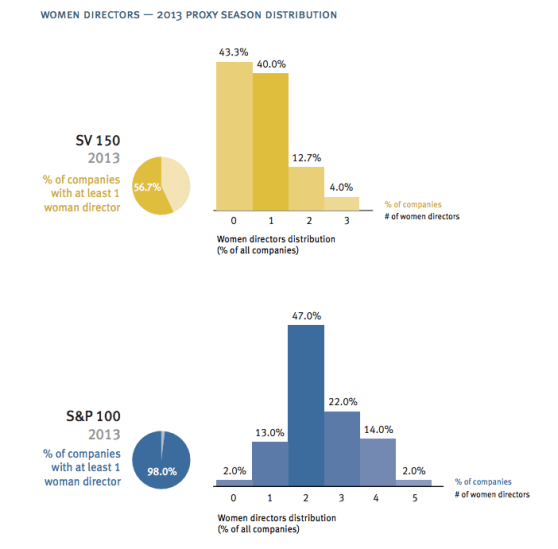Silicon Valley may have a “gender problem” when it comes to leadership, but how bad is the problem compared to other industries?
Turns out, it is pretty bad in both cases.
9.1% of Silicon Valley board members (for public companies) were women in 2013, compared to 19.9% of public companies over all.
Law firm Fenwick & West analyzed 18 years of public filings regarding boards and management teams across the Standard & Poor 100 Index (S&P 100) and the Silicon Valley 150 Index (SV 150) to identify gender diversity and leadership trends.
The silver lining here is that both indexes saw “meaningful improvement” over time. That 9.1% is up from a dismal 2.1% in 1996.
 98% of S&P 100 boards had at least one women director in 2013, and women make up an average of 20% of all S&P board members. SV 150 companies average about half that, and 43% do not have a woman director.
98% of S&P 100 boards had at least one women director in 2013, and women make up an average of 20% of all S&P board members. SV 150 companies average about half that, and 43% do not have a woman director.
That said, S&P 100 companies tend to be larger and have larger boards, which makes them more likely to have at least one women director.
“U.S. companies are reported to have the fifth highest number of women on boards as a percentage of board seats among 45 economically advanced countries,” the report said. “While there has been recurring discussion regarding the relatively low number of women directors among public company boards in Silicon Valley relative to public companies generally in the United States, our review of the data suggests that board size may be a significant factor affecting the number of women directors, and to some degree that is a function of the relatively small size of many SV 150 companies.”
Fenwick names a couple of reasons for this — CEOs generally serve on their own boards and women are underrepresented as CEOs. Venture capitalists are often board members, and women are also underrepresented in that field. Board turnover is also low, which offers limited opportunities for women to be added to boards,
Women actually represent a larger percentage of “named executive officers” in Silicon Valley, however, representing an average of 10.7 percent as opposed to the S&P 100’s 8.9%.
Fenwick also reviewed specific positions for gender diversity, including CEO, President/COO, CFO, and general counsel.
The largest public companies of the S&P 100 are more likely to have a woman serve as CEO (6% versus 2.7%), and President/COO (12.5% versus 9.6%). Silicon Valley tech companies are more likely to have a female CFO and general counsel.
Women are more likely to serve as the top sales executive in SV 150 companies, but more likely to serve as the top marketing executive in the S&P 100.
Alas, women are rarely among the five most highly paid executives in either group. We still have a long way to go.


